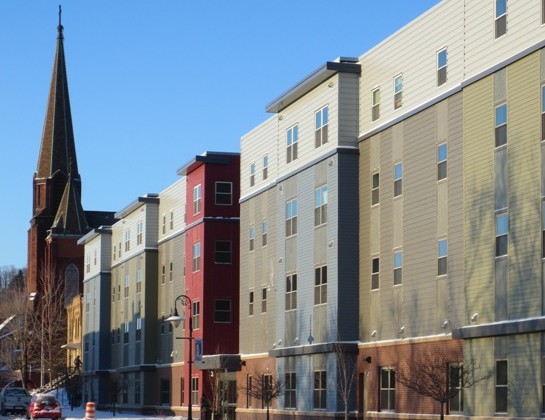 This week Minnesota Public Radio released a report describing how real estate company Madison Equities is overhauling three of their large downtown St. Paul buildings. The most visible upgrade will be the replacing the neon lighting on the iconic First National Bank Building with LED lighting. This is part of a comprehensive $12.5 million retrofit project resulting in a 40 percent reduction in energy use between the three properties. To put this in perspective, this overhaul saves enough energy to power over 1,200 homes. Madison Equities financed this project though a federal program called PACE (property assessed clean energy) that gives building owners a loan they pay back through property tax assessments which covered most of the project cost. Xcel Energy also provided $1 million in rebates as part of their Conservation Improvement Plan. And while the end result of this project will mean big savings, it actually started with a small decision – to benchmark how much energy the buildings were using in the first place.
This week Minnesota Public Radio released a report describing how real estate company Madison Equities is overhauling three of their large downtown St. Paul buildings. The most visible upgrade will be the replacing the neon lighting on the iconic First National Bank Building with LED lighting. This is part of a comprehensive $12.5 million retrofit project resulting in a 40 percent reduction in energy use between the three properties. To put this in perspective, this overhaul saves enough energy to power over 1,200 homes. Madison Equities financed this project though a federal program called PACE (property assessed clean energy) that gives building owners a loan they pay back through property tax assessments which covered most of the project cost. Xcel Energy also provided $1 million in rebates as part of their Conservation Improvement Plan. And while the end result of this project will mean big savings, it actually started with a small decision – to benchmark how much energy the buildings were using in the first place.
Across the river, the City of Minneapolis has been benchmarking large buildings since 2013, starting with public buildings over 25,000 sq. ft. and including commercial buildings over 100,000 sq. ft. and 50,000 sq. ft. in the following years. In addition to helping building mangers identify potential large retrofit projects, benchmarking also helps facility managers detect systematic errors in the way buildings function and repair them sooner. The City’s 2014 Benchmarking Report “showed a preliminary 7 percent reduction in total weather-normalized energy use intensity” in public buildings. The program has helped raise the city-wide “median score of 74” and “almost half of the scores are above the ENERGY STAR certification-qualifying threshold of 75” for qualified building types. The Minneapolis ordinance in particular is also structured so that all the energy performance data is public, creating a transparent market for energy efficiency.
In addition to Minneapolis, cities around the country have been implementing benchmarking and transparency programs. A 2012 analysis by the U.S. Environmental Protection Agency showed that buildings that are benchmarked save on average 7 percent in energy over three years. By the beginning of 2017, nearly 20 U.S. cities will have benchmarking and transparency policies. California created the nation’s first statewide benchmarking laws in 2007, with a revised version that goes into to effect in 2017 that will include multifamily housing and annual disclosure for buildings over 50,000 sq. ft. The cities of San Francisco and Berkeley have already been benchmarking on a municipal level for a number of years. Buildings represent the second-largest source of California’s greenhouse gas emissions, and reducing their energy usage through energy efficiency directly mitigates their environmental impact. Also, this updated law will better allow building owners access to tenant usage data so they can also be in compliance. Locally and nationally we’re seeing a trend toward using energy usage data to elect efficiency retrofits that result in real energy savings.
